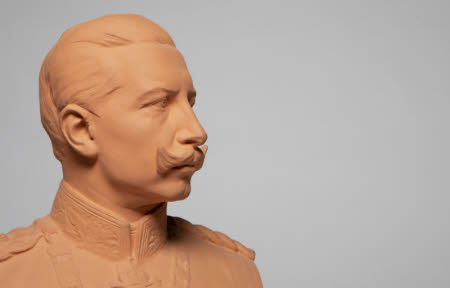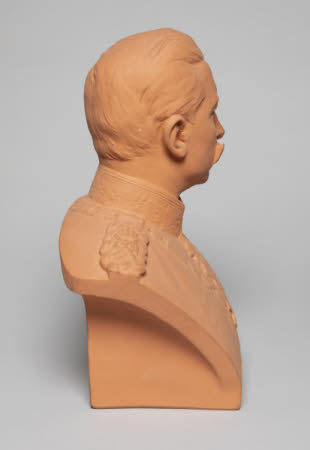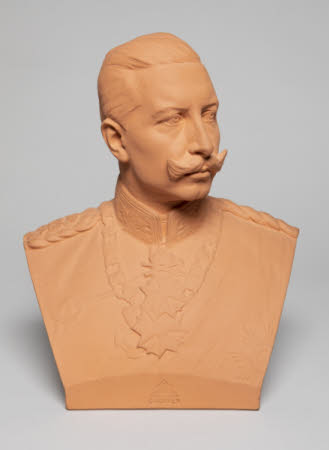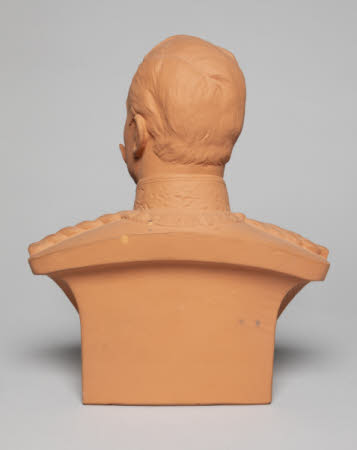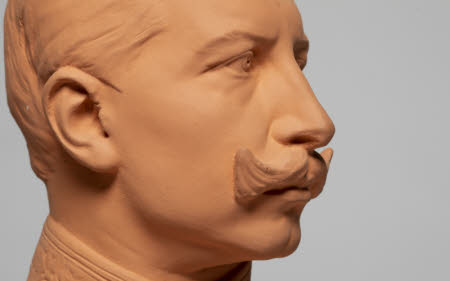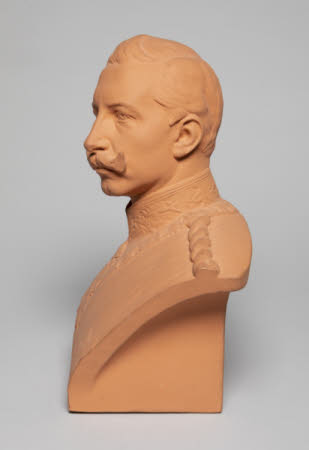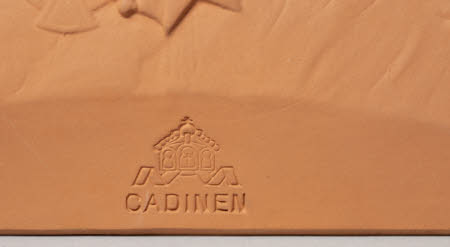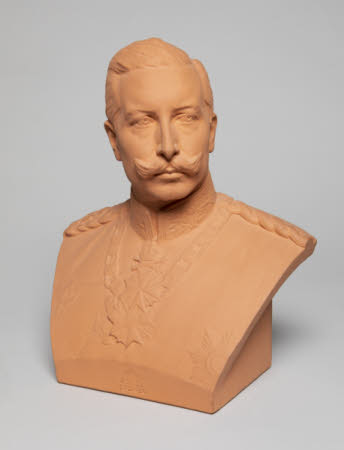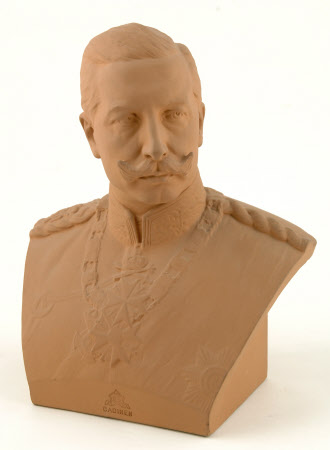Portrait bust of Wilhelm II, Emperor of Germany (1859-1941)
after Karl Ludwig Manzel (Neu Kosenow 1858 - Berlin 1936)
Category
Art / Sculpture
Date
c. 1907
Materials
Terracotta
Measurements
290 mm (H)255 mm (W)150 mm (D)
Order this imageCollection
Kingston Lacy Estate, Dorset
NT 1257633.1
Caption
The German Emperor, Kaiser Wilhelm II, Queen Victoria’s eldest grandchild, had a love-hate relationship with his British royal cousins. But he was a well-received guest at Kingston Lacy where he stayed for a week in 1907. Wilhelm sent this terracotta bust of himself to Henrietta Bankes, the chatelaine of Kingston Lacy, after his departure. He had been quite taken with the widowed Mrs Bankes, who spoke high German and had travelled the courts of Europe in her youth. In her childhood memoir, Henrietta’s daughter, Viola, recalled that the bust ‘was rather out of place amongst the marble and bronzes of Kingston Lacy so it was placed in an inglorious corner of the Saloon.’ After the outbreak of the First World War it was relegated further still and swiftly put into storage. Whilst some members of the family may have been relieved to banish this gift of dubious taste, Viola recalled that, prior to 1914, 'we were all so captivated by the Kaiser's personality that we became very pro-German.' The bust, having survived two World Wars, is now back on display – a reminder of the family ties between the last German emperor and the British royal family.
Summary
Sculpture, terracotta; Portrait bust of the German Emperor, Wilhelm II (1859-1941); Cadinen (Kadyny), East Prussia, Königliche Majolika-Werkstätte; c. 1907. The portrait of the last Hohenzollern emperor of Germany, under whose rule the first World War broke out, was made at the Emperor’s personal ceramics factory in Cadinen in East Prussia, where he had a summer home. It was presented to Mrs Henrietta Bankes (1871-1953), on the occasion of the Emperor’s visit to Kingston Lacy in late 1907.
Full description
A bust portrait in terracotta of the German Emperor Wilhelm II (1859-1941), after a model by Ludwig Manzel (1858-1936), made in the Königliche Majolika-Werkstätte in Cadinen in former East Prussia (today’s Kadyny, Poland). The bust is in herm form, with the moustachioed emperor facing to his left. He is dressed in uniform and wears several orders, including the Grand Commander’s Cross of the Royal House Order of Hohenzollern, and the Order of Merit of the Prussian Crown. Stamped on the front of the bust: CADINEN. A small chip in the top edge of bust, at back. Mounted on a rectangular varnished wooden socle with a silver label recording the bust as a personal gift from the Kaiser to Mrs Henrietta Bankes in 1908. The label is hallmarked for Robert Pringle and Sons Ltd., with a Chester assay mark for 1911. Old woodworm damage to socle at back. The Cadinen majolica factory was a private enterprise initiated by Emperor Wilhelm II, who had in 1898 acquired, as a summer country retreat, an estate near the East Prussian town of Cadinen. At this time in Germany there was a vogue for brightly-coloured glazed ceramics known in German as Majolika, so Wilhelm decided to set up his own factory in Cadinen, where there were excellent supplies of suitable clay for ceramics, and a tile industry had long flourished. The idea to establish the factory came about in the first instance, because Wilhelm had had a large painted coat-of-arms placed on one of the barns of his new estate, but had been disappointed to see the colours quickly washed off by the rain. One of his courtiers consulted the sculptor Ludwig Manzel, who had become familiar with the tin-glazed earthenware ceramics known as maiolica when studying in Italy; he suggested that the emperor should have a glazed terracotta coat-of-arms made in one of the tile factories. The result so delighted Wilhelm that he decided to establish his own enterprise to make works in terracotta and maiolica on a commercial basis. The factory, which opened between 1904 and 1905, was notable for the dominant role that the emperor exercised over it, not only as the factory’s owner and financier, but also in the very close interest he took in the selection of the products to be manufactured. The factory produced a wide range of artefacts, from busts and reliefs to bowls, vases and other ceramic forms. Given Wilhelm’s intense dislike of modern art, it is not surprising that many should have been reproductions of ancient and Renaissance models. The factory’s products were first exhibited and sold to the public in 1907, in the srt emporium the Hohenzollern-Kunstgewerbehaus, in Berlin. As well as smaller-scale works, the factory also developed a successful line in ceramic tiles for architectural settings, including underground stations in Berlin – one Cadinen frieze survives in the Klosterstraße station in Berlin. The factory survived the downfall of the Hohenzollern dynasty at the end of the First World War, continuing to operate until 1944. In 1945 Cadinen was overrun by Russian troops and was subsequently incorporated into modern Poland, under the new name of Kadyny. The maiolica factory was not reopened, although tile production continued in Kadyny. The sculptor of the model for the bust, Ludwig Manzel (1858-1936), was intimately connected with the development of the Cadinen enterprise through his personal friendship with Emperor Wilhelm II (Bloch, Einholz and Simson 1990, pp. 186-87). Born in Pomerania, as a young man he made his way to Berlin where he entered art school, supporting himself by making and selling caricatures. In the 1880s Manzel spent three years in Paris, studying in particular the work of Auguste Rodin. In the 1890s a series of works brought Manzel to greater public attention; they included 'Peace guaranteed through arms' (1890) and the 'Shipfarers fountain' made for the port city of Stettin, today’s Szczecin (1898). Manzel also made a number of monuments celebrating the Hohenzollern dynasty, helping to cement his friendship with the Emperor, who would also have appreciated Manzel’s conservative and realistic artistic style. Manzel assisted Wilhelm with the development of products for the Cadinen factory, providing many designs and models, including the portrait bust of the Emperor. The bust is a truncated head-and-shoulders version of a colossal marble bust of Wilhelm made in 1906, today in the Berlin Museum für Verkehr und Technik (Bloch, Einholz and Simson 1990, no. 156). Because the Cadinen factory was essentially a private enterprise, with commercial success being in reality secondary to satisfying the emperor’s wishes and tastes, its products were generally made in very small numbers. Manzel's bust of the emperor appears to be very rare, but there is another example in the Huis Doorn in the Netherlands, the house to which Wilhelm was exiled after the German defeat and the fall of the Hohenzollern monarchy in 1918. The Kingston Lacy bust appears to be the only work from the Cadinen factory in a UK public collection. It was a personal present to Mrs Henrietta Bankes from the Emperor, who in December 1907 visited Kingston Lacy whilst staying at nearby Highcliffe Castle, as the guest of General Stuart-Wortley. The visit was described by Henrietta’s daughter Viola Bankes (1900-89), who reminded her readers that ‘Before the War we were all intensely pro-German because of the spell left by the Kaiser’s personality on all who knew him. He was handsome in spite of his withered arm and cultured without any real learning’ (Bankes 1934, p. 42). Following Stuart-Wortley’s suggestion to Mrs Bankes that he might bring the Emperor to Kingston Lacy, the Kaiser made his way across the Dorset countryside ‘with a large suite of German officers, and the interest he excited was tremendous. In every village they drive through the inhabitants stood and waved to them and the children threw flowers at the Kaiser’s car. He saluted indefatigably and his bowler hat detracted nothing from the Imperial splendour that was usually decked in full uniform of Commander-in-Chief’. According to Viola Bankes, the Emperor and her mother, who spoke German fluently, felt an immediate attraction for each other; ‘The Kaiser stared constantly at my beautiful mother who charmed him in fluent German. He talked to no one else…’ (Bankes 1986, p. 81). The visit was a great success, its culmination the planting of a cedar tree next to one that had been planted by King Edward VII on an earlier visit in 1905. As Viola explained, the Emperor ‘sent my mother a small terra-cotta bust of himself, made in his factory at Potsdam [sic], of which he was very proud. Terra-cotta was a little out of place amongst the marble and bronzes of Kingston Lacy, so the Imperial bust occupied a remote and inglorious corner of the saloon.’ Describing the Emperor’s taste in literature as ‘more sound than his artistic judgment’, she recorded that her mother’s gifts to Wilhelm, which she evdiently regarded as more suitable, were an engraving after Romney’s portrait of Frances Woodley, Mrs Henry Bankes the Younger (NT 1257070) and a specially-bound set of the works of Thomas Hardy. Jeremy Warren April 2024
Provenance
Presented by H.I.M. Wilhelm II, German Emperor, to Mrs Bankes of Kingston Lacy, in January 1908; by descent to Ralph Bankes (1902-1981), by whom bequeathed in 1981.
Marks and inscriptions
On front of bust:: CADINEN, below factory mark On silver label on socle:: PRESENTED BY / H.I.M. WILHELM II / German Emperor / TO / Mrs. BANKES OF KINGSTON LACY / January 1908
Makers and roles
after Karl Ludwig Manzel (Neu Kosenow 1858 - Berlin 1936), sculptor Königliche Majolika-Werkstätte, ceramic manufacturer
References
Bankes 1934: Viola Bankes, Why Not?, London 1934, pp. 42-43. Watkin, 1986: Pamela Watkin. A Kingston Lacy childhood: reminiscences of Viola Bankes. Wimborne: Dovecote Press, 1986., pp. 81-82. Bloch, Einholz and Simson 1990: Peter Bloch, Sibylle Einholz and Jutta von Simson, eds., Ethos und Pathos. Die Berliner Bildhauerschule 1786-1914. Ausstellungskatalog, Berlin 1990
